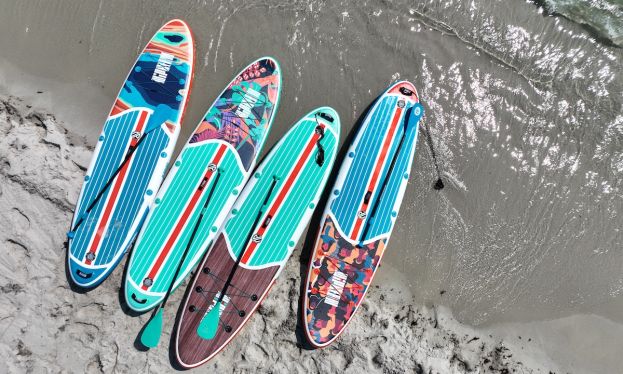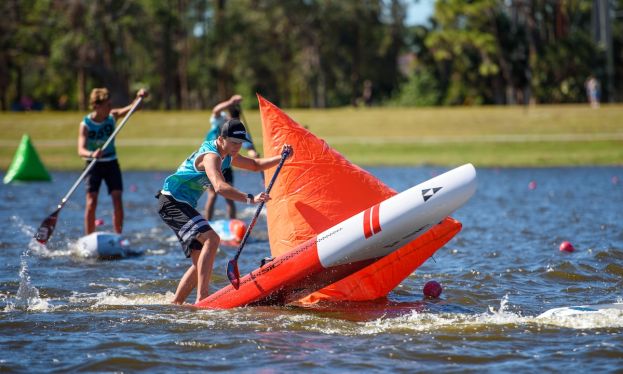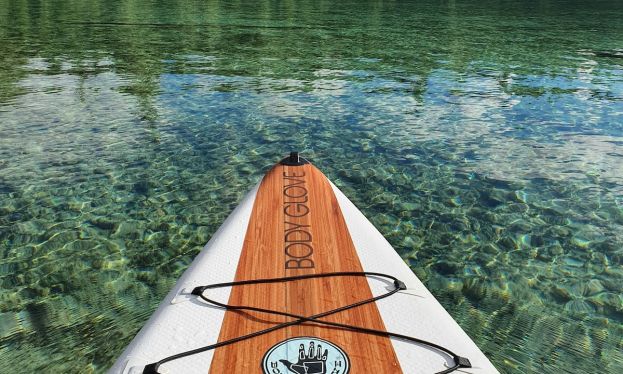10 Nutrition Tips for Peak SUP Performance
- Written by Jodelle Fitzwater
- Published in Tips
- Comments::DISQUS_COMMENTS
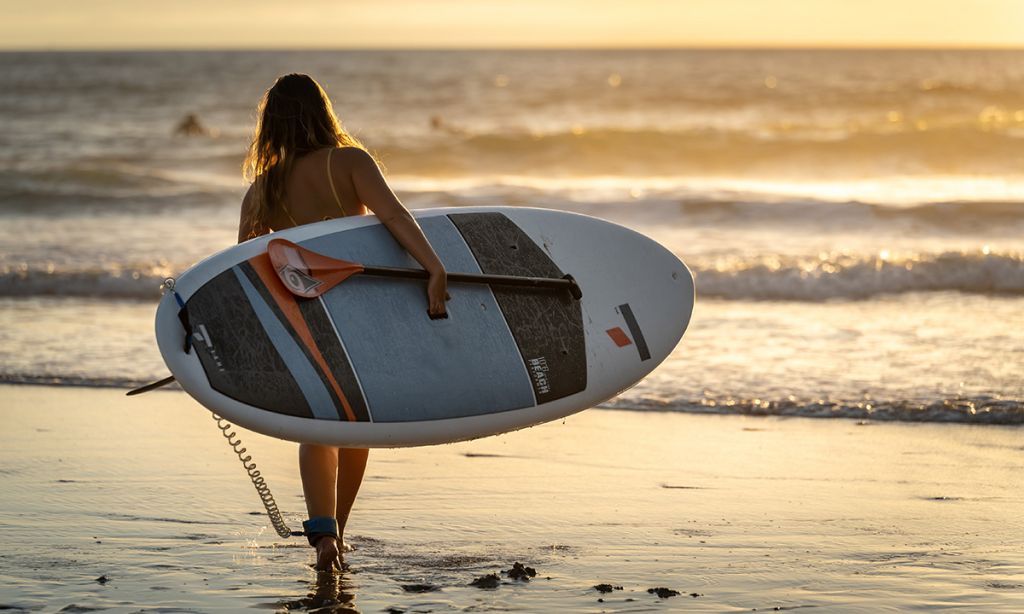 Prepare your body with the proper nutrition to get the performance on the water that you're looking for. | Photo courtesy: TAHE
Prepare your body with the proper nutrition to get the performance on the water that you're looking for. | Photo courtesy: TAHE
Nothing puts more of a damper on your downwinder than quick crash of energy and stamina. And even the most proficient of paddlers, and strategic of strokes will lose steam if the fuel coming in is lacking the proper nutrients. Whether training for your first SUP race, planning a long-distance adventure paddle, or practicing your sun salutations on the water, you simply cannot have your cake and paddle too....and feel 100% doing it. With all the physical demands on the body during a typical SUP session, from just hauling your board to and from the water, to activating stabilizer muscles just to stand on the board, to slamming down the fastest Tahitian stroke you can muster, I cannot stress enough the value of proper nutrition when it comes to SUP and fueling up for a great day on the water. So, if you are looking to increase your speed, replenish your muscles after race-training, achieve 3-legged down dog, or simply just wanting some healthy snacks to carry with you on your typical Sunday Funday, I’ve put together my Top 10 Nutrition tips to keep you SUP-er strong and paddling long!
1. Paddler, Know Thyself.
Sure you have heard that breakfast is the most important meal of the day, but you’ve also heard it said that mathematics is fun. When it comes to breakfast (and math) you should note that it’s not for everyone. It makes sense to put gas in your car before a long journey, rather than fill up at the end of a road trip, but what if the idea of eating at the start of your day gives you indigestion while paddling? The key is for you, the paddler, to know yourself and understand what your body needs and doesn’t need. While certain individuals seem to be unable to function at the start of the day without a meal, other individuals can’t seem to stomach the idea of food until around lunchtime. So which one is right? Both, depending on which one you are! And depending on what time of day you like to paddle! So here’s some tips depending on what kind of fueling up you prefer.
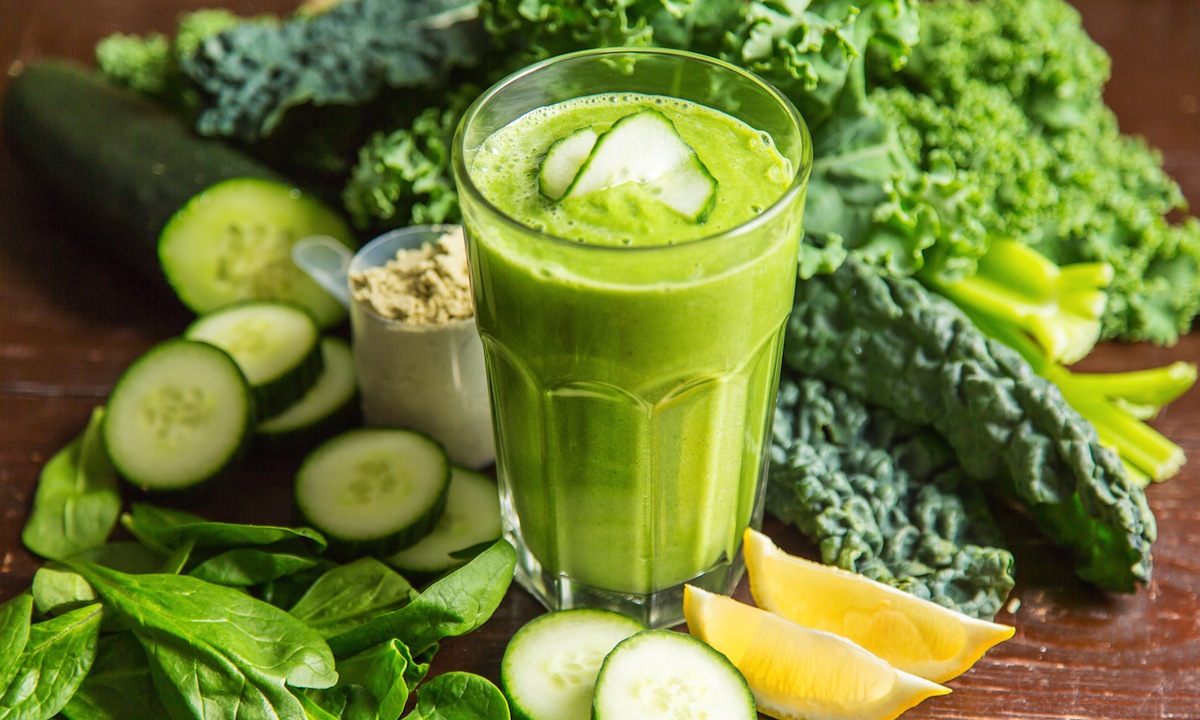 A green smoothie is the perfect way to start your day.
A green smoothie is the perfect way to start your day.
Big breakfast eaters: decide whether you need a good dose of nutrients right off the bat, and choose things like a couple of eggs scrambled in coconut oil with some spinach, or perhaps a green smoothie with a nice whey protein powder and coconut milk. A good blend of fat and protein will stick with you for a while and prevent muscle wasting as you head out on your morning paddle. What if you are the “I need something, but not much” breakfast-er? Perhaps just a piece of fruit and a hard boiled egg to give you some quick burning fuel for your fitness. And for you anti-breakfast people? Maybe just whizzing up a cup of coffee with a tbsp of powdered collagen to give you muscle-saving amino acids and prevent your body from breaking down muscle during your morning sesh.
The main theme here is to know your body inside and out and what works for your body’s unique needs. Eating just because a book or a magazine says you should won’t help your paddle, any more than fasting all day would for someone with low blood sugar. The caveat here is to keep in mind that if you aren’t a breakfast eater, and you are having trouble getting the energy you need to do your best on the water, then it’s time to ask yourself, “How’s that working for me?” Realistically if you are looking for different results, avoid doing the same thing you’ve always done, and look into some quick burning foods like fruit to power up your morning paddle, rather than a gut-bomb like a processed bacon, egg, and cheese biscuit from you-know-where.
2. Balance On and Off the Board.
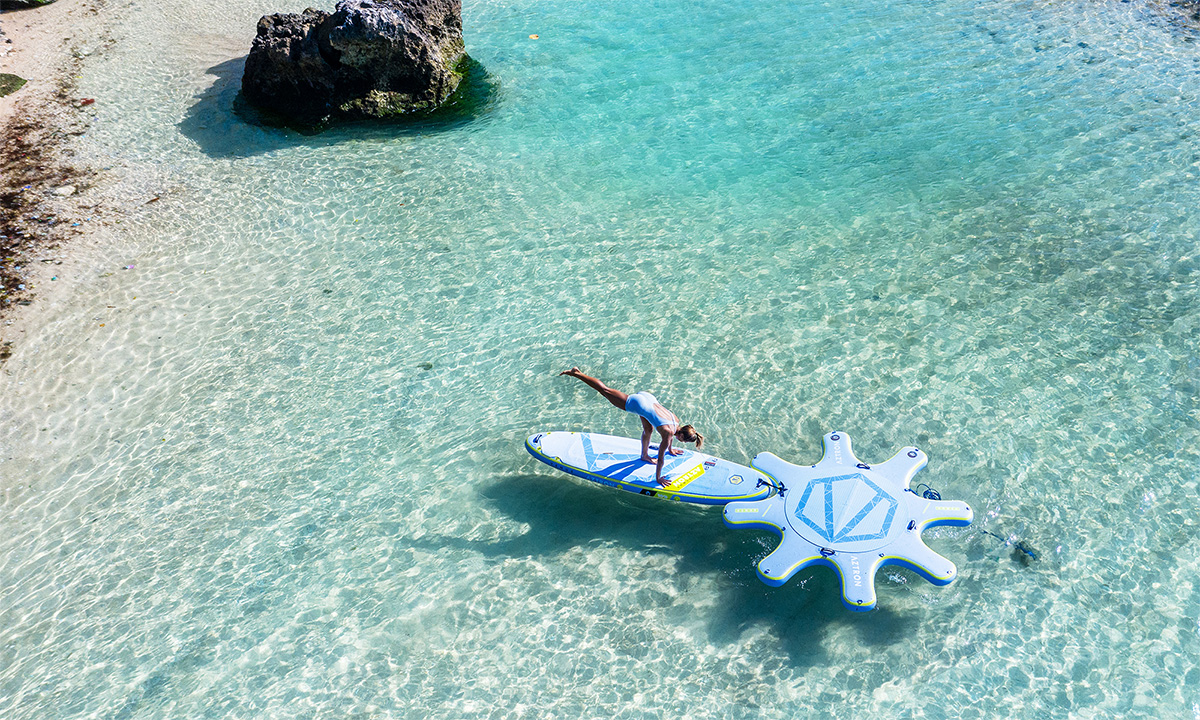 Be sure to balance your diet with three main nutrients: protein, carbohydrates, and fat. | Photo: Aztron Sports
Be sure to balance your diet with three main nutrients: protein, carbohydrates, and fat. | Photo: Aztron Sports
This means balancing the three main nutrients that every cell of your body requires - protein, carbohydrates, and fat. Yes, all three. No low-fat eating, no low-carb eating, no low-protein eating. That’s a diet. And diet’s don’t work, or we’d all be on the one that did and we would all have Kai Lenny abs. By cutting out one of these essential nutrients, you are setting your body up for low energy, low moods, and loads of cravings. Why?
Every cell of your body is made up of these 3 nutrients. 50-60% of every cell is made up of fat, 20-30% of every cell is made up of carbohydrates, and 15-20% of every cell is made up of amino acids from protein. So it stands to reason that if we ate in this balanced manner, our cellular energy would be lit and our performance on the water would be at it’s peak everyday! So what would this look like in a balanced way throughout a balanced day? Starting the day with a green smoothie, where a handful of kale and spinach and a cup of berries would be your carbohydrates, blended with 1/2 cup of coconut milk or perhaps a 1tbsp of coconut oil which would be your healthy fat, and also blended with a good vanilla protein powder (whey or pea protein based) to add that good mix of amino acids for protein!
To keep blood sugars balanced, you would want to eat this way every 3-4 hours. Lunch could be a loaded baked potato for carbohydrates, topped with 1/2 an avocado for a good dose of healthy fat, and 1/2 cup of shredded chicken or salmon for some good quality protein and sprinkled with sea salt and pepper. Perhaps an afternoon snack of some sugar snap peas dipped in guacamole for carbs and fat, and 5-6 macadamia nuts for some added protein. And finally a few hours later, dinner is done in a balanced way with a nice grilled meat for protein, some grilled zucchini and asparagus for a good carbohydrate, and perhaps drizzling a bit of grass-fed butter over your veggies for a good fueling fat. In this way, you are giving your cells balanced nutrition, to regenerate new healthy cells for stronger, faster, and fitter you both on and off the water.
3. “Water” you waiting for?
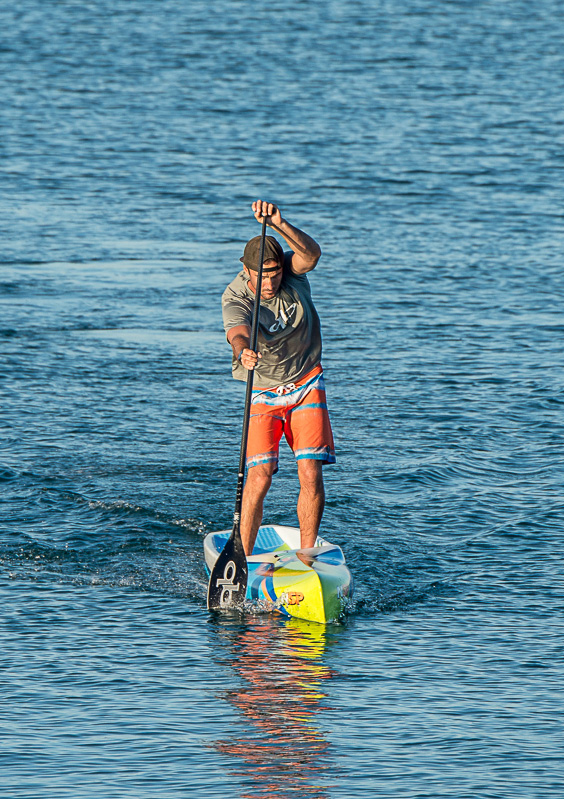 Typically most people find coffee necessary to drink, juices and sodas fun to drink, and alcohol easy to down, yet find little interest in water, until they are feeling the effects of dehydration. Yet, if 75% of our body from the neck down is made of water, and 80% of the body from the neck up is made of water, then perhaps we need to take our body’s needs for water a bit more seriously. If you have chronic, constant hunger, sugar cravings, low moods, and low energy, don’t be so quick to judge that you are a sugar-addict, an emotional eater, or suffering from depression or chronic fatigue, but instead try being your own scientific experiment and replace all your other beverages with pure filtered water. You may be pleasantly surprised with how many of your ailments start to clear up. Interestingly, a popular study was done on prisoners with peptic ulcer disease were simply given water as treatment, no other treatment, and the issue cleared up in 8 minutes. Other studies have noted most diseases inducing pain have linked the pain felt by the patient to chronic dehydration. My best tip here: drink water first when you want something to drink, and if you still want something else to drink have it after a full glass of water.
Typically most people find coffee necessary to drink, juices and sodas fun to drink, and alcohol easy to down, yet find little interest in water, until they are feeling the effects of dehydration. Yet, if 75% of our body from the neck down is made of water, and 80% of the body from the neck up is made of water, then perhaps we need to take our body’s needs for water a bit more seriously. If you have chronic, constant hunger, sugar cravings, low moods, and low energy, don’t be so quick to judge that you are a sugar-addict, an emotional eater, or suffering from depression or chronic fatigue, but instead try being your own scientific experiment and replace all your other beverages with pure filtered water. You may be pleasantly surprised with how many of your ailments start to clear up. Interestingly, a popular study was done on prisoners with peptic ulcer disease were simply given water as treatment, no other treatment, and the issue cleared up in 8 minutes. Other studies have noted most diseases inducing pain have linked the pain felt by the patient to chronic dehydration. My best tip here: drink water first when you want something to drink, and if you still want something else to drink have it after a full glass of water.
The caveat here speaks to those who over-do the water a bit. That can have consequences too, such as drawing too many electrolytes and key minerals such as magnesium out of the body, leading to muscle fatigue and cramping during paddles. To keep from losing steam during long paddles, be sure to consume a gulp or two of water every 15-20 minutes, and see my tip below under “Live Salty” to hydrate with my homemade recovery drink during and after hard sessions.
4. Don’t let the fat “snack” up on you!
Look around you as you read this and chances are you are within reach of some sort of food. We live in a society where at every stoplight, you have your choice of literally hundreds of options of foods, from gas-station grabs, to fast-food fixes, to grocery store grub. We certainly have no shortage of options. And with the tv, the radio, and internet constantly bombarding us with all the yummy new treats to run out and try, it’s no wonder we live in a “snicky-snacky-I’m-not-really-hungry-I-just-feel-like-snacking” nation. And we wonder why we are putting on weight.
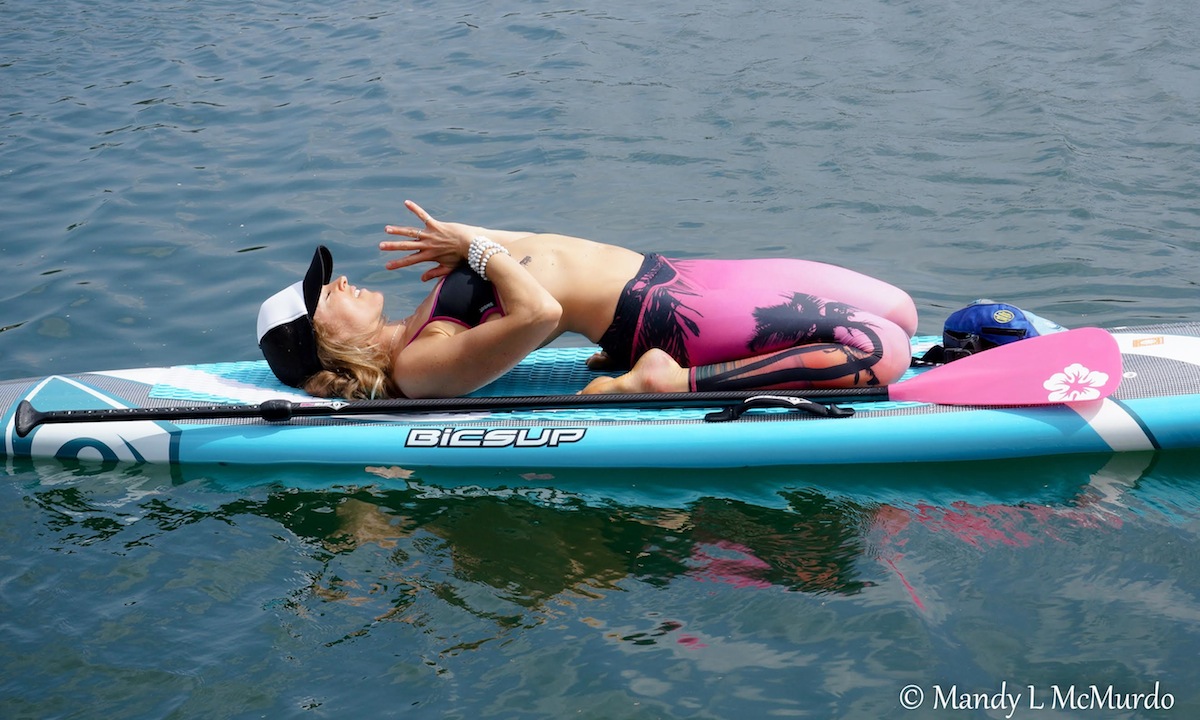 With constant snacking, the weight WILL “snack” up on you, and more weight leaves you tired, lethargic, and exhausted, not to mention not motivated to hit the water. | Photo: Mandy McMurdo
With constant snacking, the weight WILL “snack” up on you, and more weight leaves you tired, lethargic, and exhausted, not to mention not motivated to hit the water. | Photo: Mandy McMurdo
With constant snacking, the weight WILL “snack” up on you, and more weight leaves you tired, lethargic, and exhausted, not to mention not motivated to lace up your board shorts and hit the water. It’s time to get our snacking under control to benefit our bodies, rather than hinder them. How do we do this? First, focusing on tip #2 above and making sure to balance out each meal, which will make less of need for snacks between meals. This means your body will actually dip into it’s fat reserves for fuel rather than just dip into your second bag of gas-station peanuts for energy. Focusing on tip #3 and hydrating with water efficiently throughout your day, will avoid the confusion of mistaking thirst for hunger. Many times when we think we are hungry, we are actually dehydrating and our brain’s low water content is mixing up the signals being sent!
Going back to tip #1 and knowing yourself is important too, because if you tend towards hypoglycemia (low blood sugar) like myself, chances are you may need to have snacks on hand at time to keep your sugar stable. In that case, snacks that are slow digesting, such as macadamia nuts, coconut butter, avocado sprinkled with sea salt and eaten right out of the shell makes great quick healthy snacks. Baby carrots and sugar snap peas dipped in guacamole, a piece of dark chocolate atop a spoonful of coconut oil, and a couple deviled eggs are nice to nosh on as well. Vermont Real Sticks is a nitrate-free beef stick company that makes safe and healthy sticks to keep with you on the SUP, as well as companies that make convenient nut butter squeeze packets. Dried fruit like medjool dates are quick fuel, pop-in-your-mouth treats, that are great for endurance paddling, as well as making your own energy bites to bring on board with you...which brings me to my next tip....
5. SUP takes balls.
You heard right, it takes balls to take your nutrition to the next level and prepare some foods in advance to keep you well nourished, and well energized. Recently on a 40 mile paddle, I made my favorite SUPer Energy Balls, which are little nut butter balls mixed with several different easy ingredients that you can simply pop in your mouth while you paddle your buns off. Here’s a recipe for my favorite ones, with some ideas below it to show you what other delicious things you can add to make it your own!
Jodelle’s SUPer Energy Balls
- 1/2 cup Macadamia, almond or coconut butter
- Half cup of gluten-free oats or buckwheat groats
- Scoop of whey protein powder
Directions: Soften the nut butter & mix with the oats. Mix in the protein powder and finish off with cacao nibs or raisins. Mix thoroughly and mould into balls and keep in the freezer until you’re ready to take ‘em on board in a baggie to pop in your mouth when you need an energy boost.
Options to add in: cacao nibs or raisins, other chopped nuts, shredded coconut (or roll each ball in shredded coconut), chia seeds, sunflower seeds, roll in sesame seeds is a nice treat, chopped dried fruits like dates or apricots, chopped dark chocolate, a bit of spirulina for added greens!
Balls or bites like this are a simple and easy way to always have nutrition on board and your energy pumping.
6. Don’t go pro.
Pro-inflammatory that is. Foods that cause inflammation in the body will definitely prevent you from “giving her all she’s got, Captain”. When your joints hurt, when your bursa is inflamed, and when your brain is fogged up with neurological inflammation, that doesn’t really make you wanna run right out and jump on your board. Certain foods help heal the body and certain foods harm the body. The three most common inflammatory foods are: gluten, dairy, and sugar. While there are others, these three sadly include many of the standard foods eaten by society today.
Cereal for breakfast, a sandwich for lunch, and pizza or pasta for dinner is a recipe for inflammation in your gut, joints, and tissue the next day, and when this way of eating becomes the norm, that’s when we see chronic inflammation everyday. For your learning pleasure, gluten-containing foods are those such as cereals, breads, bagels, pretzels, pastas, pizza, pastries, cookies, cakes, and anything made from flour. Dairy causes excess mucus in the body which can cause sinus infections and inflammation as well as bowel inflammation and backup like constipation.
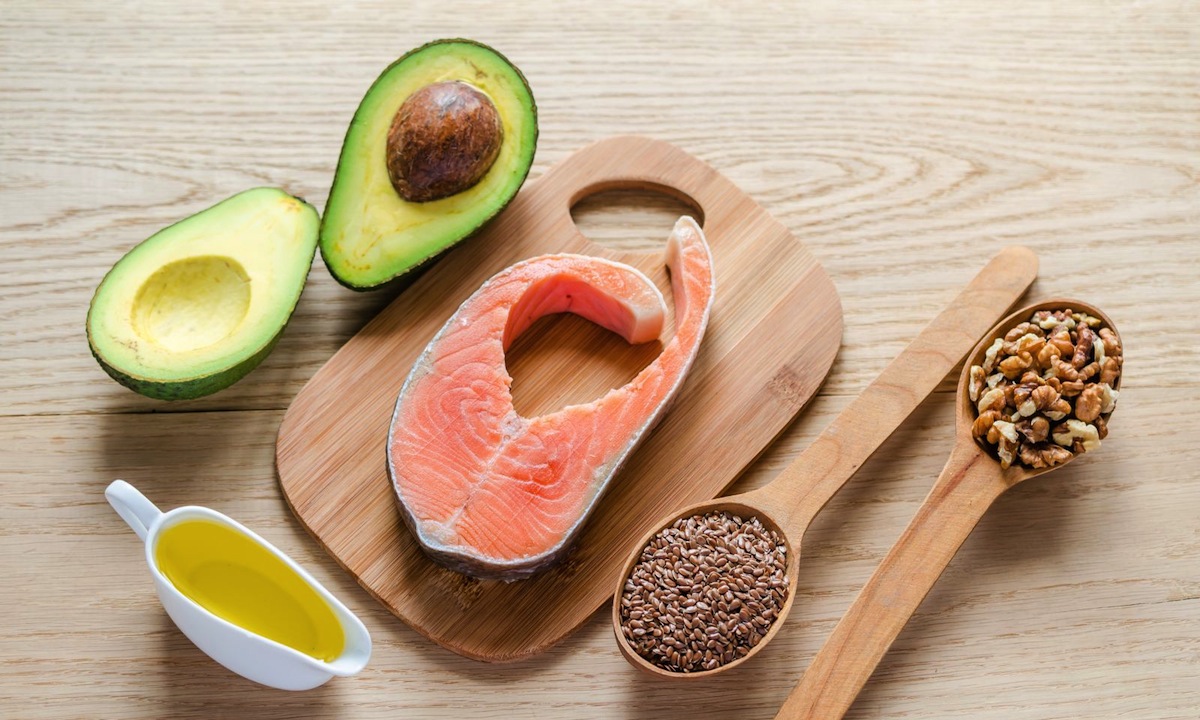 Your body could use a lot more of healthy fats like olives and avocado, and anti-oxidant-rich foods blueberries, garlic, and wild-caught salmon.
Your body could use a lot more of healthy fats like olives and avocado, and anti-oxidant-rich foods blueberries, garlic, and wild-caught salmon.
Processed sugars and even too much sugar in the form of fruit can create too much insulin in the body, creating inflammation around each cell of our body eventually leading to insulin resistance. Insulin resistance is the pre-cursor to Type 2 diabetes, the number one killer in the US. Instead, your body could use a lot more of anti-inflammatory foods such as dark leafy greens, loads of cruciferous veggies like broccoli and cauliflower, healthy fats like olives and avocado, and anti-oxidant-rich foods blueberries, garlic, and wild-caught salmon. These foods thwart and even reverse inflammation and can help heal ailments within the body preventing you from feeling your best and getting on the water.
See more articles from SUP expert Jodelle Fitzwater here.
7. Live Salty.
 Photo courtesy: Surftech
Photo courtesy: Surftech
Salty hair and ocean air - nothing better, right? But there is more to living salty than just getting salty. After a nice long session on the water, you have most likely lost a good amount of key electrolytes, especially sodium. Sodium loss happens through the sweat during exertion. Your sweat contains between 2.25 - 3.4 grams of salt per liter, and the rate of water and salt loss as you perspire in a long, hot race can easily average 1 liter per hour. Recently on my 40 miler, it took just under 12 hours, so I could have easily lost approximately 27 to 41 grams of salt.
Ever had a hard workout and felt how salty your skin was afterwards? That’s the sodium leaving your body! And just replenishing with water won’t cut it. Too much water can draw out even more electrolytes and minerals. After a nice long paddle, you must replace the sodium you have lost so that your body has the sodium to keep the body running optimally. Why? Your body’s cells use sodium and other electrolytes to carry electrical impulses that help your cells communicate with each other and essentially “light up” ability to taste, see, smell, touch, and hear - all very important functions both on and off the board. So a recovery drink post-paddle (not just water) is crucial to restoring the body back to functioning efficiently. And in order to help you live salty, I’ve included my homemade recovery drink, that you can make easily with just a few simple ingredients:
Jodelle’s Homemade Post-Paddle Recovery Tonic
- 1 large bottle of water (around 16-20oz)
- 1 tsp of baking soda (a little more for men and if you’ve paddled for more than 2 hours)
- 1 tbsp of apple cider vinegar (again a little more if you require a bit more)
Stevia or a dash of pure maple syrup to tasteSimply mix altogether and enjoy your own recovery soda of sorts. When you mix vinegar with baking soda, you get a bit of fizz as well as amped up hydration! Vinegar lubricates the joints and aids in digestion, and the baking soda creates a balance of sodium back in the body and helps create a more alkaline environment in the body. No need to spend your hard-earned dough on expensive recovery drinks. Now you can easily and quickly make your own.
8. Go green!
 Vegetables, specifically dark leafy greens like kale, spinach, broccoli and the like are the only known food sources that help to draw out and detox the synthetic extra estrogens out of the body.
Vegetables, specifically dark leafy greens like kale, spinach, broccoli and the like are the only known food sources that help to draw out and detox the synthetic extra estrogens out of the body.
Dark leafy greens, that is! A healthy body that is functioning optimally, meaning “all systems in the body are GO” requires the proper balance of minerals, amino acids, and hormones. In our modern, industrialized society, we are bombarded with things called “xenoestrogens” or synthetic estrogens found in carpets, processed foods, clothing, plastics, and much more leading to an over-abundance of toxic estrogen build-up in the body. When this happens, our hormones are out of balance and we see women acquiring a bit more curves in places they didn’t intend to be curvy, and a case of the “man-boobs” in men who more than likely didn’t intend for those either. Vegetables, specifically dark leafy greens like kale, spinach, broccoli and the like are the only known food sources or super green that help to draw out and detox these synthetic extra estrogens out of the body. No portion control when it comes to veggies. Your body literally can’t get enough of the green stuff, so eat all you want, and as you do you will be detoxing out those damaging synthetic estrogens so that the liver can do its job of regulating stored body fat for energy, and help you lose the weight and feel great!
See more paddle boarding tips here.
9. SUP-plements.
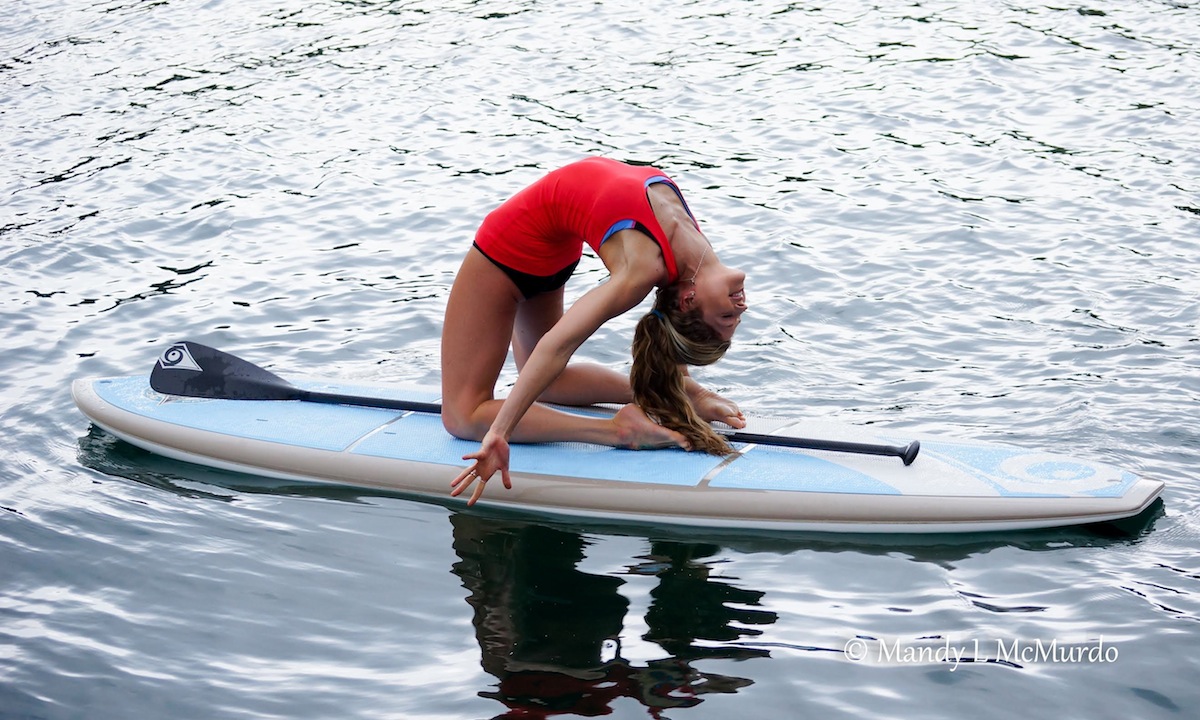 Using certain supplements can kelp to keep your body strong with all of the avid excercising a dedicated stand up paddler endures. | Photo: Mandy McMurdo
Using certain supplements can kelp to keep your body strong with all of the avid excercising a dedicated stand up paddler endures. | Photo: Mandy McMurdo
As an avid exerciser both on and off the water, its imperative that I supplement with a few key things to keep my body humming along and my PaddleFit classes strong! As I mentioned above when discussing electrolytes, and magnesium, your calming mineral is another that is lost through lots of activity, physical and mental stress such as that of a SUP race or endurance paddle, as well as lost in the heat which is what many people are paddling in.
So, supplementing with magnesium is crucial to consider if any of the above relates to you. Look for a magnesium glycinate which is the most absorbable form and start with at least 400mg if you experience muscle cramping after or during paddles, perhaps building up to 1000mg per day, which is what I tend to take on heavy activity days. Other key supplements to consider are Zinc, which is also depleted through lots of physical activity and stress; Vitamin D if you wear a lot of sunscreen or SPF protective clothing and aren’t absorbing it from the sun. Always take Vitamin K2 along with Vitamin D3, as this helps it become the most absorbed by the body. There are other supplements that can help with energy and stamina for paddling, but those are unique to certain individuals. Talk with your doctor before starting any supplement and always perhaps work alongside a Nutritionist like myself to help decide what dosage is right for you.
10. Bugs on board.
Before you get the “heebee-jeebee’s” and shiver, let me set the record straight that I’m talking about the good bugs we want within our gastro-intestinal tract. Good beneficial bacteria is critical to healthy digestion and elimination, making key “feel good” neurotransmitters for the brain such as serotonin, and for amping up immune function to keep you from becoming ill. Your gut makes up 70% of your immune system and your intestinal gut bug ratio influences your immunity greatly. Too much yeasty-bacteria and you will have low energy, brain fog, fatigue, trouble eliminating, and lots of sinus trouble and allergies. Yet, with a good balance of helpful bacteria such as bifido bacteria and lactobacillis, your immune system will flourish, your energy will be lit, and your brain will feel like a well-oiled machine.
How is one to create a balance of good bugs vs. harmful bugs? By eating to feed the good bugs, and starve off the harmful bacteria. Sugar of all kinds, processed carbohydrates, sodas, and juices all feed your harmful bacteria, so crowding those out with foods that feed your good bacteria like blueberries, sauerkraut, garlic, plantains, onions, and potatoes will set up a much more healthy environment for your beneficial, good guys to flourish. On top of that, consider supplementing just one bottle of a good strain of bifidus bacteria and lactobacillus acidophilus to restore a more normal ratio and send an army of good guys within you to go to paddle against harmful pathogens.
Think about this as well: many of the waterways we paddle on are not as clean as we may like, unfortunately, and we are exposing ourselves to amoebas, bacteria our bodies have never seen, and parasites that can potentially be deadly to us. Yet with an entourage of good bacteria within, we can rest assured we have extra protection to keep from becoming ill, and keep our immune system fighting anything we may come in contact with when we fall in “the drink.”

You’ve got the board you love, you’ve got the paddle that fits you, you’ve got your PFD to protect you, and now you have the nutrition know-how to keep you fueled and fabulous out there on the water. For more info on acquiring a customized nutrition meal plan that is unique to your individual needs, consider setting up a personalized nutrition therapy consult with myself, either in person or over the phone or skype, to get your nutritional needs met no matter what ailments or issues are hanging around. Visit my website: www.getfitwithjodelle.com or email me at getfitwithjodelle@gmail.com Happy paddling and happy healthy noshing!
Written by: Jodelle Fitzwater, CNC, CFPC, CPI, BiC SUP Pro Athlete, e-RYT200, and self-proclaimed mermaid.

Jodelle Fitzwater
Branson West, Missouri - Jodelle Fitzwater has been a yoga instructor for over 15 years, and a SUP instructor for over 5 years. She's a BiC SUP Pro Stand Up Paddle Ambassador, SUP TV Fitness & Yoga Host, Certified PaddleFit Instructor, ACSM Certified Personal Trainer, and Certified Nutrition Coach. Oh, yea, and self-proclaimed mermaid.
Website: www.getfitwithjodelle.com/ Email This email address is being protected from spambots. You need JavaScript enabled to view it.


